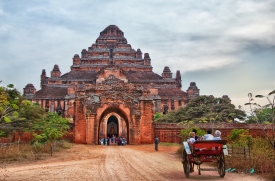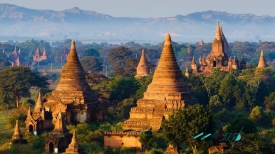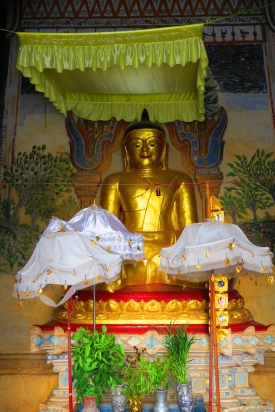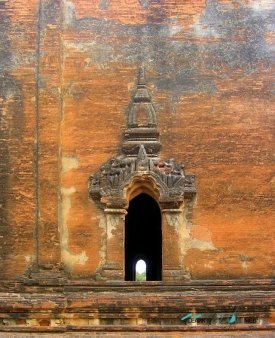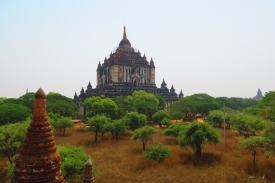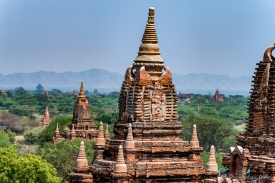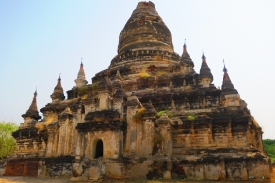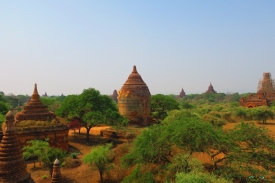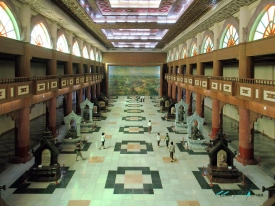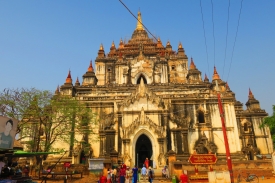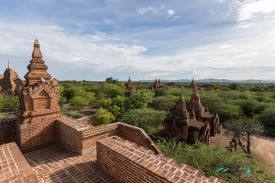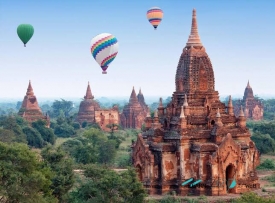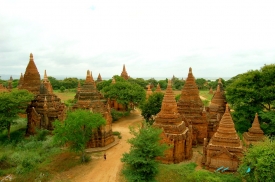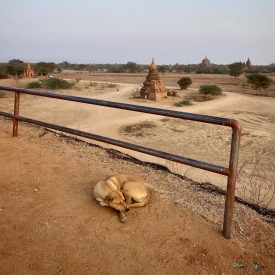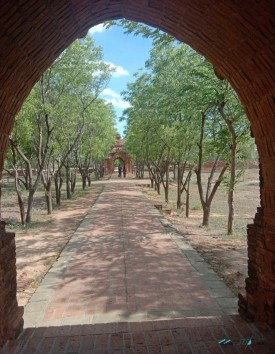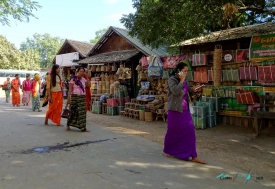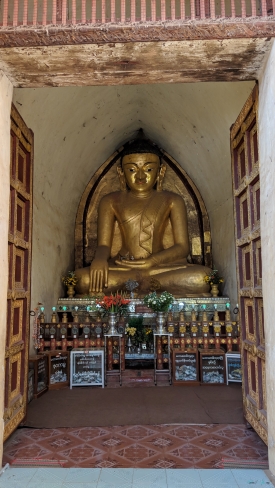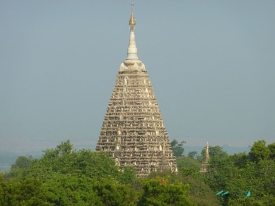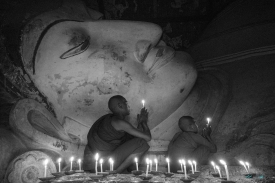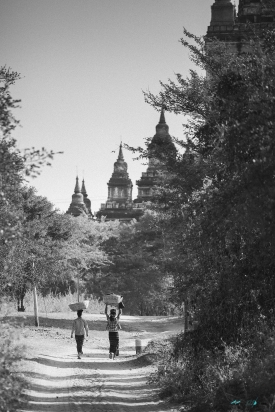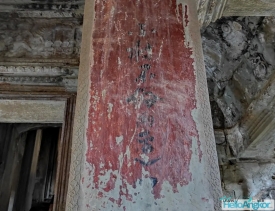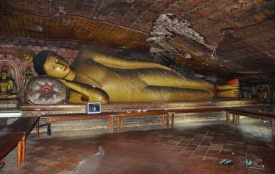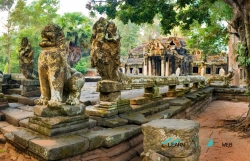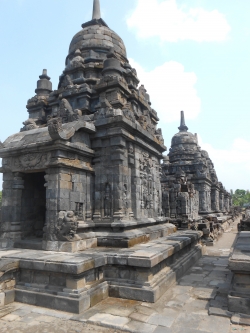ABOUT Bagan
Bagan, is a vast Buddhist archaeological site of nearly 50 square kilometers located in the Mandalay Region, in the central plain of Burma, on the left bank of the Irrawaddy. From the 9th century to the 13th century, it was the capital of the kingdom of Pagan, the first Burmese empire.
Occupied by several villages or hamlets often built near groups of temples, it is in an earthquake zone and has suffered numerous earthquakes which have caused serious damage, one of the most important and destructive having taken place in July 1975 .
An inventory of the site's monuments was subsequently drawn up by Pierre Pichard, of the École française d'Extrême-Orient (EFEO), with the help of several local collaborators. As part of this eight-volume inventory published between 1992 and 2001, the monuments were measured, photographed and their plans drawn, each one, in addition to the name it may bear, receiving a number. This inventory lists 2834 monuments, many of which are in ruins.
Several monuments were restored after the 1975 earthquake, but from the 1990s a wave of restorations undertaken under the aegis of the Burmese government as well as the construction of a golf course and a tower observation point in the middle of the site has given rise to many comments, often very critical, from Western art historians and archaeologists. These restorations, which are often assimilated to reconstructions, are financed by donations from the faithful Buddhists.
Bagan was inscribed on the UNESCO World Heritage List on July 6, 2019.
The occupation of the site by the Pyus seems to have begun around the middle of the 7th century AD. A few very rare vestiges of the time have survived, sometimes concealed in later monuments built around them, or as perhaps the Bu-hpaya, a stūpa whose bulbous shape reproduces that of the stūpas built at Pyay (anc. Prome) by the Pyus. The greatest period of architectural activity took place between the 11th and 14th centuries. This period, which marks the hegemony of Burmese power in the region, makes the Pagan plain the largest Buddhist archaeological site in Asia, with several thousand monuments.
The historical events which upset the 13th century coincide with the decline of the city and the displacement of the capital towards Ava, in the northeast, marks the end of this long period. Bagan was never completely abandoned, however, remaining a site of pilgrimage.
There will be a period of renewal in the 18th century: several monuments are then built such as the Upali-thein, a hall for the ordination of monks, built in 1793-1794.
Monuments are built of brick or, more rarely, partially excavated, partially constructed. They were entirely covered with a white coating (stucco) which has often disappeared; the door and window frames are given a particularly refined treatment with jambs sometimes adorned with large scrolls adorned with animals and flowers and a polylobed tympanum inserted in the representation of a tower.
The old city of Bagan which occupies the right angle where the river breaks its course towards the West and heads towards the South; it is surrounded by walls still partially preserved, including the door of Tarabha on the western wall. It is likely that its initial plan was quadrangular and that its western wall was eroded by the river.
Several temples and stupas are located there: the Pathohtamya (with paintings), the Nat-hlaung-kyaung (a Brahmanic temple), the Mahabodhi temple (a replica of the Bodhgaya temple), the Bu-hpaya (a silhouette stupa bulbous built on the bank of the river), the Gawdaw-palin and the That-byin-nyu (two “temple-mountains”) in particular.
In 2020, during the covid-19 pandemic, looters took advantage of the absence of tourists and the understaffing of the police and firefighters given the size of the site to attack him. At the beginning of June 2020, a dozen pagodas were looted. The exact loot has not been released, with police saying only coins and relics, but the site had not faced so much looting in decades. However, the better preserved and more prestigious, better guarded pagodas are spared.
Occupied by several villages or hamlets often built near groups of temples, it is in an earthquake zone and has suffered numerous earthquakes which have caused serious damage, one of the most important and destructive having taken place in July 1975 .
An inventory of the site's monuments was subsequently drawn up by Pierre Pichard, of the École française d'Extrême-Orient (EFEO), with the help of several local collaborators. As part of this eight-volume inventory published between 1992 and 2001, the monuments were measured, photographed and their plans drawn, each one, in addition to the name it may bear, receiving a number. This inventory lists 2834 monuments, many of which are in ruins.
Several monuments were restored after the 1975 earthquake, but from the 1990s a wave of restorations undertaken under the aegis of the Burmese government as well as the construction of a golf course and a tower observation point in the middle of the site has given rise to many comments, often very critical, from Western art historians and archaeologists. These restorations, which are often assimilated to reconstructions, are financed by donations from the faithful Buddhists.
Bagan was inscribed on the UNESCO World Heritage List on July 6, 2019.
The occupation of the site by the Pyus seems to have begun around the middle of the 7th century AD. A few very rare vestiges of the time have survived, sometimes concealed in later monuments built around them, or as perhaps the Bu-hpaya, a stūpa whose bulbous shape reproduces that of the stūpas built at Pyay (anc. Prome) by the Pyus. The greatest period of architectural activity took place between the 11th and 14th centuries. This period, which marks the hegemony of Burmese power in the region, makes the Pagan plain the largest Buddhist archaeological site in Asia, with several thousand monuments.
The historical events which upset the 13th century coincide with the decline of the city and the displacement of the capital towards Ava, in the northeast, marks the end of this long period. Bagan was never completely abandoned, however, remaining a site of pilgrimage.
There will be a period of renewal in the 18th century: several monuments are then built such as the Upali-thein, a hall for the ordination of monks, built in 1793-1794.
Monuments are built of brick or, more rarely, partially excavated, partially constructed. They were entirely covered with a white coating (stucco) which has often disappeared; the door and window frames are given a particularly refined treatment with jambs sometimes adorned with large scrolls adorned with animals and flowers and a polylobed tympanum inserted in the representation of a tower.
The old city of Bagan which occupies the right angle where the river breaks its course towards the West and heads towards the South; it is surrounded by walls still partially preserved, including the door of Tarabha on the western wall. It is likely that its initial plan was quadrangular and that its western wall was eroded by the river.
Several temples and stupas are located there: the Pathohtamya (with paintings), the Nat-hlaung-kyaung (a Brahmanic temple), the Mahabodhi temple (a replica of the Bodhgaya temple), the Bu-hpaya (a silhouette stupa bulbous built on the bank of the river), the Gawdaw-palin and the That-byin-nyu (two “temple-mountains”) in particular.
In 2020, during the covid-19 pandemic, looters took advantage of the absence of tourists and the understaffing of the police and firefighters given the size of the site to attack him. At the beginning of June 2020, a dozen pagodas were looted. The exact loot has not been released, with police saying only coins and relics, but the site had not faced so much looting in decades. However, the better preserved and more prestigious, better guarded pagodas are spared.
The Best Pictures of Bagan
Videos of Bagan











